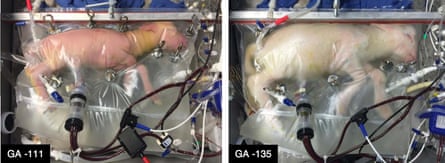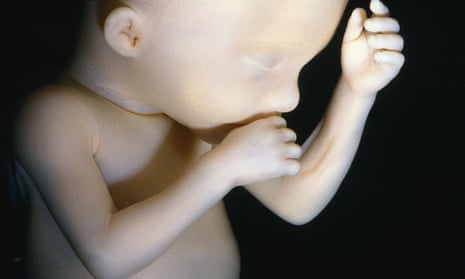An artificial womb designed to support critically premature babies has been demonstrated successfully in animals for the first time, in an advance that could transform the lives of the most fragile newborns.
Lambs born at the equivalent of 23 weeks in a human pregnancy were kept alive and appeared to develop normally while floating inside the transparent, womb-like vessel for four weeks after birth. Doctors said that the pioneering approach could radically improve outcomes for babies born so early that they cannot breathe, feed or fight infection without medical help.
Alan Flake, a foetal surgeon at the Children’s Hospital of Philadelphia (CHOP) and lead author, said the proposed system could act as an urgently needed bridge between the mother’s womb and the outside world for babies born at between 23 to 28 weeks gestation.
“If we can support growth and organ maturation for only a few weeks, we can dramatically improve outcomes for extremely premature babies,” he said.
The team is in discussions with the US Food and Drug Administration (FDA) and predicts that babies could be incubated in the system within three years in the first clinical trial.

During the past decades, the limit of viability for premature babies has been steadily pushed back to about 23 weeks, but a high proportion of these babies still suffer severe and permanent health problems as a result of their early birth.
Doctors who treat babies born at 23 weeks – just past the midway point of a normal pregnancy – have to balance multiple competing risks to keep the infant alive and minimise the harm caused by invasive interventions and surgery.
These babies typically weigh about 1lb, their eyelids are sealed and they tend to have a rosy hue because their skin is so thin that the blood shows through.
Their immature lungs have a few air sacs with thick walls, rather than millions of tiny alveoli, in which oxygen is readily absorbed by the blood. If oxygen levels drop, heart and brain damage occur. But ventilation is also dangerous as premature lungs lack a surfactant which protects against the effects of oxygen, which can be toxic to tissue. Too much oxygen can lead to abnormal growth of blood vessels in the eye, which can leave the baby blind.
Emily Partridge, a doctor for critically premature infants at CHOP and a co-author, said: “Just looking at them it’s immediately clear that they shouldn’t be here yet, they’re not ready.”
In the study, published in Nature Communications, six premature lambs were placed in artificial wombs immediately after caesarean deliveries at the equivalent of 23 weeks human gestation. Within minutes of birth, the lamb was sealed in the biobag, linked to a gas exchanger by their umbilical cord, allowing their blood oxygen to be replenished and nutrients to be infused.
In the biobag, the lambs were immersed in a substitute amniotic fluid containing nutrients and chemicals designed to stimulate growth. While floating inside the transparent plastic vessel – in some cases for four weeks – the lambs appeared to develop normally, transforming from bald, pink foetuses into fleecy, white newborns.
Tests on the animals revealed their lung function matched that of age-matched controls and the oldest lamb, which is now more than a year old, appears completely normal.
Partridge described the apparatus in operation as “an awe-inspiring sight”, but the authors acknowledge that the public may be wary of the technology.
“I don’t want this to be visualised as humans hanging on the walls in bags,” said Flake. “This is not how this device will work or look.”
The human version will have the appearance of a fluid-filled incubator, with a dark cover and interior, and the baby would be monitored by cameras. Flake predicts that such a set-up, while unfamiliar, is likely to be less distressing for parents than the current situation in which fragile infants typically undergo a host of invasive procedures, including intubation, ventilation and surgery.
The authors also ruled out the prospect of an entire gestation taking place externally, as depicted in Aldous Huxley’s Brave New World, where babies are routinely decanted into the world from artificial wombs.
“The reality is that at the present time there’s no technology on the horizon,” said Flake. “There’s nothing but the mother that’s able to support that [initial] period of time.”
In the UK, around 60,000 babies – one in nine – are born prematurely each year needing specialist hospital care.
The chance of survival at 22 weeks is close to zero, but the odds quickly improve for every extra day the baby stays in the womb. At 23 weeks the chance of survival is 15%, at 24 weeks 55% and at 25 weeks about 80% (this figure was just 53% in 2006).
However, health outcomes have not improved as quickly as survival figures for very premature babies, with one study showing that 45% of children born before 26 weeks had serious cognitive impairments at 11 years.
The possibility of prolonging a baby’s effective gestation period outside of the womb has long been viewed as the holy grail for treating extremely premature infants, but until now scientists have struggled to realise this immense technical challenge.
Neil Marlow, professor of neonatal medicine at University College London, said that the latest study would be viewed as a significant step towards this goal. “This is real tomorrow’s world stuff,” he said. “They appear to have got lambs through four weeks which is a pretty momentous achievement.”
Colin Duncan, professor of reproductive medicine and science at the University of Edinburgh, agreed the study was a major advance, but was less optimistic than the authors about the timeline to clinic: “The use of steroid injections for women at risk of delivering a premature baby to help accelerate foetal lung development was discovered using sheep models. It has improved the survival of premature babies worldwide and made a huge impact on obstetric and neonatal practice. That treatment took well over 20 years to get into clinical practice.”

Comments (…)
Sign in or create your Guardian account to join the discussion